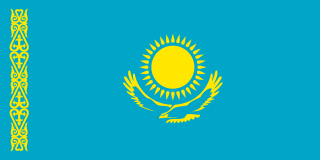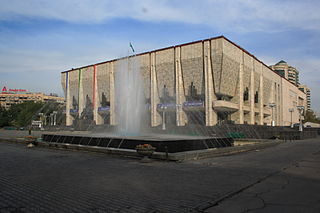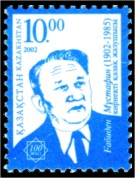
Kazakhstan, officially the Republic of Kazakhstan, is a landlocked country mostly in Central Asia, with a part in Eastern Europe. It borders Russia to the north and west, China to the east, Kyrgyzstan to the southeast, Uzbekistan to the south, and Turkmenistan to the southwest, with a coastline along the Caspian Sea. Its capital is Astana, while the largest city and leading cultural and commercial hub is Almaty. Kazakhstan is the world's ninth-largest country by land area and the largest landlocked country. It has a population of 20 million and one of the lowest population densities in the world, at fewer than 6 people per square kilometre. Ethnic Kazakhs constitute a majority, while ethnic Russians form a significant minority. Officially secular, Kazakhstan is a Muslim-majority country, although ethnic Russians in the country form a sizeable Christian community.

Kazakhstan, the largest country fully within the Eurasian Steppe, has been a historical crossroads and home to numerous different peoples, states and empires throughout history. Throughout history, peoples on the territory of modern Kazakhstan had nomadic lifestyle, which developed and influenced Kazakh culture.

The Kazakh Soviet Socialist Republic, also known as Soviet Kazakhstan, the Kazakh SSR, or simply Kazakhstan, was one of the transcontinental constituent republics of the Soviet Union (USSR) from 1936 to 1991. Located in northern Central Asia, it was created on 5 December 1936 from the Kazakh ASSR, an autonomous republic of the Russian SFSR.

The national flag of Kazakhstan, also called the Kazakh flag, was adopted on 4 June 1992, replacing the flag of the Kazakh Soviet Socialist Republic. The flag was designed by Shaken Niyazbekov.

The state anthem of the Kazakh Soviet Socialist Republic was the national anthem of Kazakhstan when it was a republic of the Soviet Union and known as the Kazakh SSR.

The Kazakh Autonomous Socialist Soviet Republic, abbreviated as Kazak ASSR and simply Kazakhstan, was an autonomous republic of the Russian Soviet Federative Socialist Republic (RSFSR) within the Soviet Union which existed from 1920 until 1936.

The emblem of Kazakhstan was adopted on 4 June 1992. The designers of the emblem are Jandarbek Melibekov and Shot-Aman Ualikhan. About 245 projects and 67 description designs of the future arms took part in the final competition. Like other post-Soviet republics whose symbols do not predate the October Revolution, the current emblem retains some components of the Soviet one, in this case, rising sun rays and star. Prior to 1992, Kazakhstan had an emblem similar to all other Soviet Republics.
Football in Kazakhstan is governed by the national body the Football Federation of Kazakhstan. The FFK organises the men's, women's and futsal national teams. Football is the most popular sport in the country, followed by ice hockey.

The Alash Autonomy, also known as Alash Orda, was an unrecognized Kazakh provisional government, or proto-state, located in Central Asia and was part of the Russian Republic, and then Soviet Russia. The Alash Autonomy was founded in 1917 by Kazakh elites, and disestablished after the Bolsheviks banned the ruling Alash party. The goal of the party was to obtain autonomy within Russia, and to form a national, democratic state. The political entity bordered Russian territories to the north and west, the Turkestan Autonomy to the south, and China to the east.

Oleksiy Mustafin is a Ukrainian media-manager, journalist, and politician.
Life or Death may refer to:
The Writers' Union of Kazakhstan is a Kazakh literary organization, established in the 1930s. Since its inception at least 750 of Kazakhstan's top writers have been affiliated with the union.
Ghabiden Mustafin, previously until 2002 Tokarevka, is a town in Karaganda Region, Kazakhstan, with a population of 3,997.
Farhat Mustafin, also spelled Farkhat or Farkhad, is a Russian former wrestler of Volga Tatar descent who competed for the Soviet Union in the 1976 Summer Olympics where he won a bronze medal in Greco-Roman wrestling as a bantamweight.
Qazaqstan Radio and Television Corporation is one of the largest media companies in Kazakhstan. It runs four TV channels: Qazaqstan, Qazsport, Balapan, Abai TV; and four radio stations: Qazaq Radiosy, Shalkar, Astana, and Classic. There are also 14 regional TV channels that are part of the corporation.

The Kazakh famine of 1930–1933, also known as the Asharshylyk, was a famine during which approximately 1.5 million people died in the Kazakh Autonomous Socialist Soviet Republic, then part of the Russian Socialist Federative Soviet Republic in the Soviet Union, of whom 1.3 million were ethnic Kazakhs. An estimated 38 to 42 percent of all Kazakhs died, the highest percentage of any ethnic group killed by the Soviet famine of 1930–1933. Other research estimates that as many as 2.3 million died. A committee created by the Kazakhstan parliament chaired by Historian Manash Kozybayev concluded that the famine was "a manifestation of the politics of genocide", with 1.75 million victims.
Mustafin is a Bashkir, Tatar and Uzbek masculine surname, which is common in the countries of the former Soviet Union; its feminine counterpart is Mustafina. It may refer to:

Auezov Theater with a full name of Kazakh State Academic Drama Theater named after M.O. Auezov is located on Kurmangazy Street in Almaty, Kazakhstan near the Esentai River.
Gakku TV is the first music channel in Kazakhstan that only airs content produced in Kazakhstan.
The frequency of Y haplogroups in percent among Kazakh tribes.











